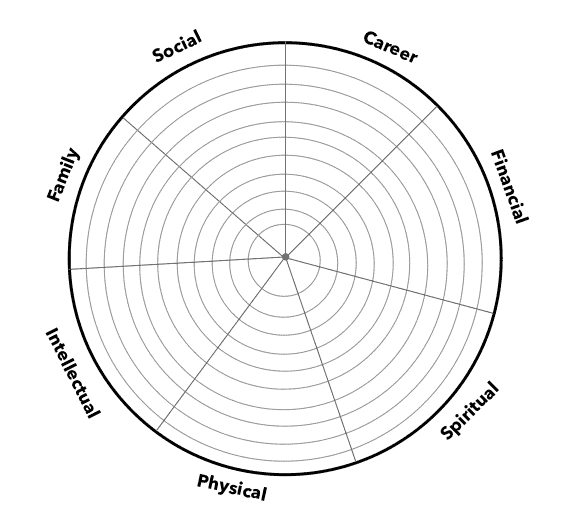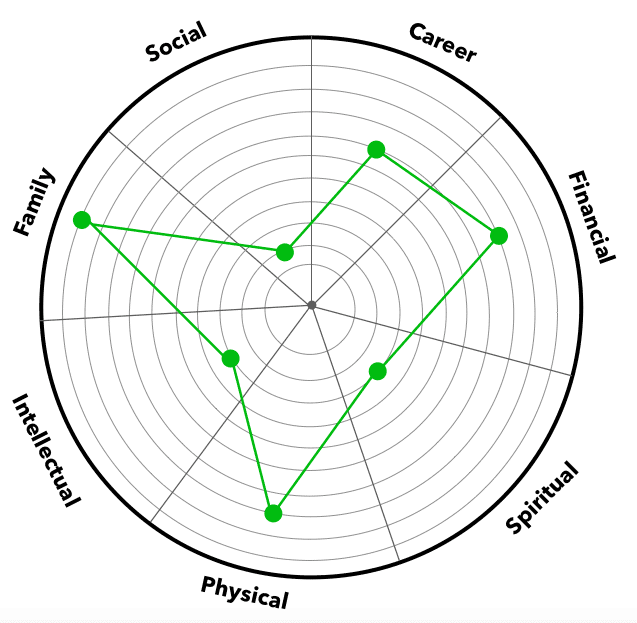The Wheel of Life
One of the best personal growth and development tools for just about anybody is the Wheel of Life. It is an extremely simple tool, but it can provide a lot of insight into how you are living and how that differs from the way that you want to live. The wheel of life is a circular chart that is unique to each individual who uses it. When you use and apply it, it can help you balance all of the important aspects of your life and ensure that you are focusing on the right things.
Wheel of Life Definition
A natural place to start with the wheel of life is defining what it actually is and why people use it. The Wheel of Life (sometimes called a life wheel) is a circular diagram made up of seven key areas of your life. To use it, you rate each of these areas on a scale from 1-10. This gives you a visual representation of where you are fulfilled and focused and where you need to spend more energy.
The wheel of life was originated in the 1960’s as a business and life coaching tool, but has evolved over the years as more people have used it and applied it. It’s still a favorite of business coaches and has been popularized by the likes of Zig Ziglar, Tony Robbins, Paul J. Meyer and others. While it’s still a favorite tool for career and business coaching, many other people have adopted it to help find balance in life.

Purpose and Application
This tool is used by everyone from religious leaders to psychologists to business coaches and life coaches. It’s great as a coaching tool because it doesn’t take much time, but will give coaches a sense of how one’s life is going. The purpose of the wheel of life is to give an objective score to how areas of your life are going so that you can track it over time. By seeing where you are succeeding and where you are falling short, you can start to develop a personal growth plan to improve all areas of the wheel.
Wheel of Life Categories
Since it is circular, the categories in the wheel of life are in no particular order. That’s kind of the point. You want to have balance between each of these areas. The categories that make up the wheel of life are:
- Career
- Financial
- Spiritual
- Physical
- Intellectual
- Family
- Social
Career
This area applies whether you own a business, work as a freelancer, are employed at a company or are even retired. Take a look at how you are doing in your career in terms of earnings, responsibility, personal development, career path growth, or whatever else is important in your business. You spend a lot of your time working, so you want to make sure you have the right skills, outlook, management, ideas, and job position to become happy in your career.
Financial
While it’s easy to have some overlap with business and career, the financial category is really more about your personal finances. Your score should reflect how you are feeling about money and if you are achieving the goals that you have set for yourself in this section of the wheel.
Spiritual
Regardless of your belief system, this area still applies. How are you doing in your spiritual practice? Do you have a consistent spiritual practice? Do you feel that you need to spend more time focusing on it? Whether this is religion, meditation, mindfulness, or just being in touch with the laws of the universe, it’s good to check in on how you’re doing here.
Physical
This is focused on health and wellness. This would include diet, exercise, overall medical health, and self-care. Try not to worry too much about your body image, but objectively assess how healthy you are at this point in your life.
Intellectual
This category of the wheel is focused on the level to which you are intellectually stimulated. Many people use this area of the wheel to look at reading, learning, travel, culture, and the pursuit of education.
Family
This includes your relationships with your immediate family as well as important extended family members. Do you feel like you have happy, secure, loving relationships? Are there specific people or groups of your family that you would like to be closer to or have better relationships with?
Social
Finally, we get to social. To achieve balance in your wheel of life, you must also be filling your cup with social interaction. This includes your relationships with your friends and coworkers, but also your social schedule and how you spend your time. Perhaps you want to take up different activities when you are socializing or find a new group of friends that share a similar interest.
Simplify Your Life Course
Take the 13-step course to learn intentional living by focusing on what is truly important in life while getting rid of the rest.
How do you fill out a wheel of life?
Start with a template
To fill out a wheel of life, it’s best to use an actual visual diagram. Some people try to use a spreadsheet or write it out as a journal entry with just text. A lot of the value lies in being able to see the areas laid out in front of you.
Rate each area on a scale of 1-10
For this part, you can simply write a number on a piece of paper or in the margin next to the wheel diagram. Think carefully about how each of these areas are today. Make sure you aren’t writing down what you aspire to be, or what you think you should be. This is an assessment of where you are right this moment.
Fill in the wheel of life diagram
The wheel of life has rings that grow from small in the center to large at the outside. 1 would be the very center of the circle and 10 would be the very edge. You will draw a dot for each of the 7 areas that represents the score you gave it. From there, you will draw straight lines to connect each of the dots to the category next to it. This will give you a shape that shows where you are strong and where you need to improve.

Use the wheel to assess where you currently stand
It’s amazing how this one visual can immediately show you the current balance of each area of your life. As you see which areas dip closer to the center of the circle and which ones fall near the outside, it will illuminate where you are today. From this visual, you can start to determine what you want to continue, eliminate, improve, learn, or achieve.
Set your goals and build a plan
Once you have a concrete and objective view of the wheel of life, you can start to take action. The next step is to build your own personal development plan and set your goals for each area. I recommend setting goals specific to each of the categories of the wheel so you can keep them focused.
To make these goals as effective as possible, they should be SMART goals, or as close as you can get to that. This means that they should be specific, measurable, achievable, realistic and timely. By setting goals that you can definitively say that you achieved or missed, you will be able to track progress and show improvement.
Revisit the Wheel of Life often
While the Wheel of Life can be insightful the first time you use it, the real value comes from making it a practice. Check back on yourself regularly over time and give new scores. You can save and compare your wheels to see what is changing in your life as you implement your plans.

Different Applications of the Wheel of Life
The beauty of the wheel of life is that although it is a time-tested framework, you can always tweak it and make your own rules. It can be just as powerful if you apply it in different ways. You know best what will make you feel satisfied and balanced in life, so don’t feel like you have to follow all the rules exactly. Here are a couple different ways that you can use it:
Create your own categories
When using the wheel of life as a coaching tool for yourself or others, all of the traditional areas may not directly apply. You might have something in your life that is more important than one or two of the standard categories. Feel free to replace a category or two, or write your own seven categories entirely. Start with a blank wheel and write in the categories, then go through the came exercise with the tool.
Minimalism and the Wheel of Life
As very strong proponents of a minimalist lifestyle, we like to embrace the principles of simple living as much as possible. You can create a separate version of the life wheel that focuses on simplifying your life. Using a minimalist lens and creating your own categories, it could include categories such as:
- Home Design
- Clutter
- Digital Minimalism
- Schedule and Routine
- Self-Care
- Personal Style
- Mindset
- Diet
- Productivity
You can really make these areas fit with whatever is most important to you when it comes to simplifying your life.
Create your own Wheel within each category
After you have filled out and examined your original wheel, you might see an area or two that you really want to focus on. For instance, if you feel great about your health, friends, relationships, and career but feel that you need to improve financially, you can create your own wheel for that. The seven categories within finance could include things like budgeting, attitude towards money, income, savings, investments, charitable giving and taxes. You can see how paying attention to each of the areas within one category can help lead you to set better goals and achieve success.
Benefits of Wheels of Life
While you will hear business coaches or life gurus talk about the power of the life wheel to completely transform your life on its own, this may be a bit aggressive. The point of the wheel is to take the the time to focus on areas of your life and determine how to achieve more balance. It’s not often that we get to take the time we need to really evaluate how we’re doing in an objective way. When done properly, some of the benefits of the life wheel include:
- Better self-awareness
- Improved goal setting
- Ability to balance all the areas of your life
- A framework for self coaching that is cheaper than a paid coach or therapist
- Elimination of the things that throw off your balance or impede your life
- A view of how you are growing over time
Get Started
Once you have a clear understanding of the wheel of life and areas that you should evaluate, the next step is to start. Figure out the areas where you need more balance. Set goals for each of the categories. Tweak it to reflect what is important to you. Get coaching or additional help in areas that you feel you need more improvement. It shouldn’t take a lot of time to start seeing the benefits of this wonderful coaching tool. If you have any questions as you go through this process, feel free to reach out to us.
If you are looking for resources, Our Simplify Your Life Course starts out with the wheel of life and works you through a process to simplify each of these areas and will help you get to your goals faster.